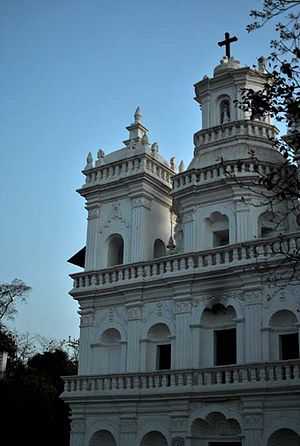Moira, Goa
| Moira मयडें Moiddem | |
|---|---|
| Village | |
 Moira Location of Moira in Goa | |
| Coordinates: 15°35′39″N 73°50′24″E / 15.59417°N 73.84000°ECoordinates: 15°35′39″N 73°50′24″E / 15.59417°N 73.84000°E | |
| Country | India |
| State | Goa |
| District | North Goa |
| Sub-district | Bardez |
| Time zone | IST (UTC+5:30) |
| Postcode | 403507 |
| Area code(s) | 0832 |
Moira ([mɔjɽɛ̃ː]) is a village in North Goa, India. It has been home to a number of notable individuals from Goa,[1] and is known for its bananas (known as Mundollchim kellim in Konkani).
<span id=""Legendary village of wise fools"">"Village of wise fools"
Glenis Maria D'Souza, a native of Moira, describes the village and its people: "If you behave a little idiosyncratic [sic] in Goa, don't be surprised if you are called a 'Moidekar'. The legendary village of wise fools, Moira, is a cozy hamlet well located in the heart of Bardez, cuddled on either side by the Mapusa river branch of Mandovi and its Uskoi branch."[2]
Early history

Historian Teotónio de Souza published a brochure on Moirá for its church's 350th anniversary in 1986. When the church was built, two Flemish brothers lived in Goa: diamond dealers Jacques and Joseph de Coutre. At the beginning of the 17th century, the arrival of the Dutch in the waters around India led the Portuguese administration in Goa to keep a close watch on the Dutch. Some, including the Coutre brothers, were arrested and sent back to Lisbon. Coutre's autobiographical account in manuscript is in the National Library of Spain. In it, he describes his adventures in Goa and elsewhere in Asia.
A deed drawn up in Goa on 14 March 1623 and preserved in the National Library of Lisbon records that Joseph de Coutre (known as "Couto" in Goa) financially assisted the Franciscans to build the first Moira church. This conflicts with the story told by Paulo de Trindade, who said that the church was financed entirely by the Moidekars.
The Augsburg-born businessman (1559–1637) had links to Augsburg bankers. Although he was better connected than the Coutre brothers in Portuguese circles, he was expelled in 1624. Cron contributed to the chapel for St. Francis Xavier on the eve of Francis' canonisation and tried to help the Capuchins, but the casados (white settlers) thought he was a Dutch spy and he was expelled. Like the Coutre brothers, his wealth gained him favour in the Spanish court (which ruled Portugal at the time).
Goa Inquisition
Although men and women were arrested by the Holy Office of the Inquisition during its auto-da-fé in the cathedral on 7 December 1664, Moira was relatively unscathed by the Portuguese Inquisition.
Families
Local historian Leroy Veloso has identified five vangodd (founding families, or clans) in Moira.[3] According to Veloso, the third vangodd is a composite of families with a number of surnames. They include Jack de Sequeira, Erasmo Sequeira, Carmo Azavedo, John Maximian Nazare and Silvestre Nazaré.
Notable residents
- Jack Sequeira – Politician
- Erasmo de Sequeira – Former Member of Parliament for South Goa
- Carmo Azavedo – Former editor of O Heraldo
- Goculdas S Nagvenkar – Former FIFA assistant referee
- John Maximian Nazare – Believed to have been Asia's first Queen's Counsel
- Silvestre Nazaré – Nuclear scientist[4]
- Manuel Francisco D'Cruz – Educator
- Anthony da Silva, SJ – Provincial of the Jesuits of the Goa Province
- Teotonio R de Souza – Historian
- Maxwell Anthony Francis Pinto – Social worker
- Joaquim D'souza- Ex GM of Mapusa Urban Co-operative Bank
- Floriano Lobo – Social activist and founder of the Goa Su-Raj Christian Party
- Augusto Pinto – Educator
- Deepa Awchat – Chef
- Theodore Francis Mendonca – Labour-law attorney
- Eve D'Souza – Radio and television personality[5]
- Loretta D'Souza e Shreedharan – Field hockey player
- Rishad D'cruz - Director & winner of Special Jury Award -IFFI Goa.
St. Xavier High School
St. Xavier High School is a co-educational school run by the Diocesan Society of Education in Panaji and founded in 1935. It is recognised by the Goa Board of Secondary and Higher Secondary Education in Porvorim and the Directorate of Education in Panaji.
References
- ↑ Noronha, Frederick. "Goans are all over the world, doing all kinds of things". Geocities.com. Retrieved 22 September 2014.
- ↑ D'souza, Glenis Maria. "The Majestic Village of Moira". Goacom.com. Retrieved 22 September 2014.
- ↑ Veloso, Leroy (13 September 2007). "Kulachars in Moira". Moira-Net. Retrieved 22 September 2014.
- ↑ "Profiling a Moiranet Member: Dr Silvestre Nazare". Moira-Net. 9 April 2007. Retrieved 22 September 2014.
- ↑ http://www.thejackalnews.com/default.php?dll=1673%20&readmore=1